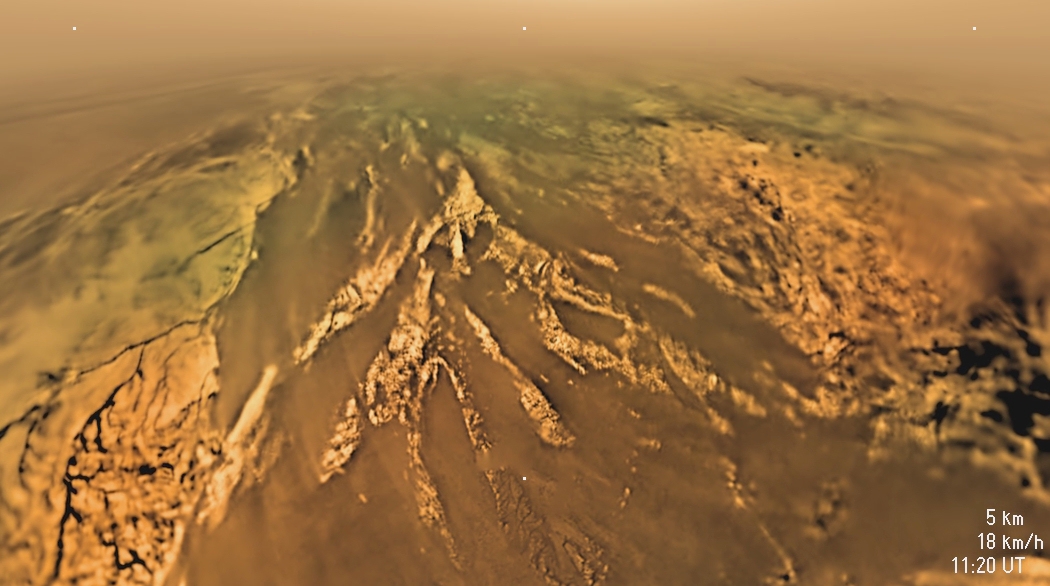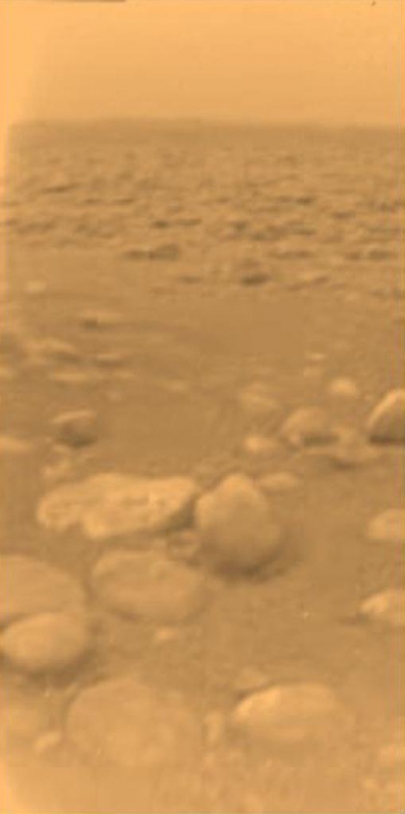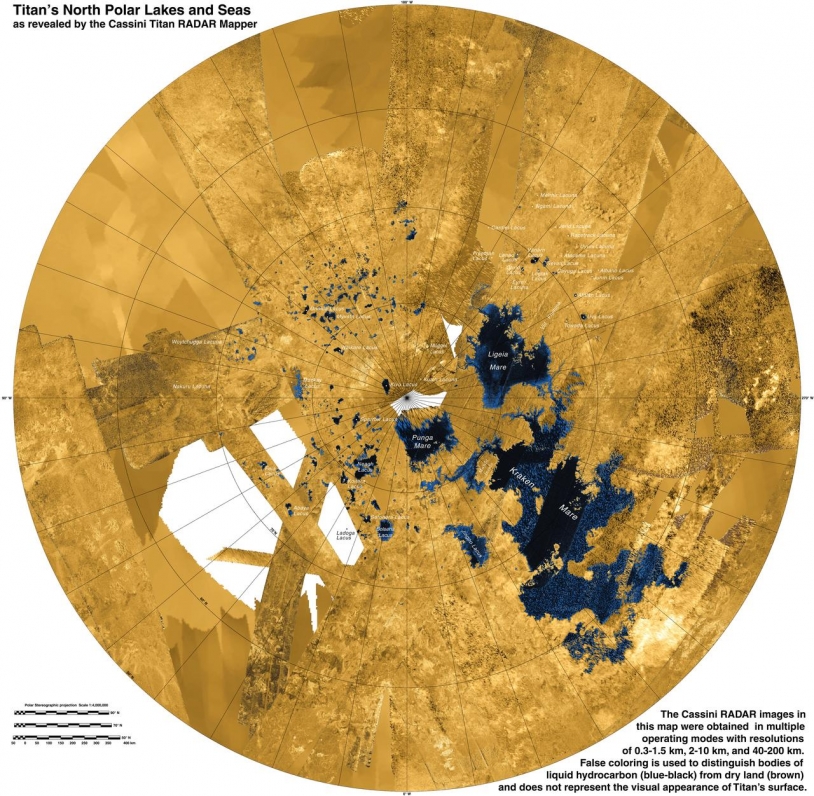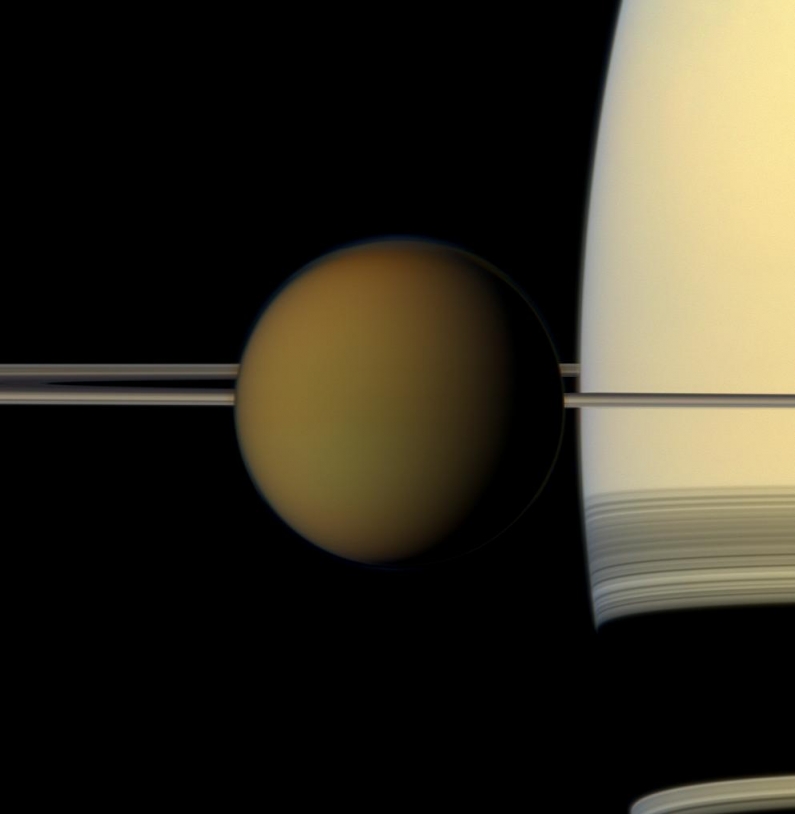Beneath the veil of clouds
Titan is the only known moon with an actual atmosphere rather than just trace gases. Like Earth, its atmosphere is rich in molecular nitrogen—98% compared to 78% on our planet—and has the same layered structure (troposphere, mesosphere, etc.), but it’s about 10 times more extensive at 1,200 kilometres thick.
With a surface pressure 50% greater than on Earth and 7 times less gravity, Titan’s atmosphere is so thick and dense that it was long thought the largest natural moon in the solar system. Since its surface was revealed by the Voyager 1 mission in 1980, we know that Titan is in fact 5,150 kilometres in diameter, making it the second largest moon after Jupiter’s Ganymede.
“Titan was long seen as an analogue of primitive Earth,” recalls Athéna Coustenis. “We now know it has very little oxygen, like primitive Earth, but with similarities and differences that make it a unique object worthy of close study. Everything we already knew about its atmosphere was thanks to the Voyager flybys that discovered molecular nitrogen, and to ground observations.
The European Southern Observatory (ESO) also performed observations in the infrared that revealed dark and bright regions on Titan’s surface but were unable to determine their composition. The hypothesis was that there must be hydrocarbon oceans to explain the 1.6% of methane still present today in the atmosphere. Cassini and Huygens showed us that they’re in fact lakes of methane and ethane.”
While the Cassini spacecraft divided its time between Saturn, its moons and rings, Titan was the single focus of the European Huygens mission. The two spacecraft were designed to operate together, Cassini in orbit scanning Titan’s surface and atmosphere, and Huygens accomplishing a descent and landing lasting one day to obtain in-situ data on the surface, each confirming the other’s results.
“The two spacecraft were designed to complement one another,” confirms Athéna Coustenis. “I believe that’s why the mission has been such a success. Another reason is Cassini’s longevity, which has been key to studying seasonal phenomena and climatic effects.”
Descent to Titan
Released by Cassini on Christmas Day 2004, Huygens entered Titan’s atmosphere on 14 January 2005 at an altitude of 1,600 kilometres and began its two-and-a-half-hour descent. It started acquiring detailed data 170 kilometres from the surface, including measurements of the atmosphere’s composition, pressure and temperature, and of the electrical field. When it was just 700 metres from the surface, Huygens switched on its lamp to illuminate the landing area. It then landed softly in an ancient lakebed strewn with water-ice pebbles likely eroded by past flows of methane.
“Huygens is the probe to have landed farthest from Earth in our solar system,” continues Athéna Coustenis. “It’s a technological miracle, really, surviving against all the odds, as it was initially designed as a descent module, not a lander. Huygens was nevertheless carrying a penetrometer to measure the consistency and resistance of the soil, but no other measurements were planned on the surface and most of the data were acquired during the descent. The mission could maybe have been even more ambitious, with more instruments operating after the landing, but increasing the complexity also means more things can go wrong.”

Panorama of Titan viewed by Huygens during its descent. Credits: ESA/NASA/JPL/University of Arizona
The module was able to analyse its new environment for 30 minutes on the surface of Titan before its batteries ran out, with Cassini serving as a relay with Earth. Ground radiotelescopes were also used to retrieve additional data before the lander finally ceased transmitting. But that didn’t mark the end of the mission for the science team. The raw data obtained will be keeping them busy for years and could lead to new discoveries like in 2012, when Huygens’ radio and conductivity measurements helped confirm the hypothesis of an internal subsurface ocean.
“The surface is separated from the interior and the crust doesn’t rotate at the same rate as the core. Current models suggest this points to a liquid water ocean, probably lying between two layers of ice, unlike on the moons Europa and Enceladus where the ocean is thought to be in direct contact with the core. We don’t know exactly how deep this ocean is, but it’s very extensive, likely holding 10 times all the water on Earth.”

Titan’s surface viewed by Huygens on 14 January 2005. Credits: ESA/NASA/JPL/University of Arizona
An ocean of life?
Where there’s liquid water, there could be life, but many other ingredients are needed. The organic chemistry in Titan’s atmosphere, based on molecular nitrogen and methane, has already revealed prebiotic molecules being formed. There is also a source of energy confirmed by the presence of cryovolcanism (ice volcanoes), so nearly all of the conditions for a habitable world are in place.
“The potential for exobiology on Titan is very high,” confirms Athéna Coustenis. “It’s lacking oxygen and remains a very cold world, but the nitrogen atmosphere is at the right pressure. Geophysicists are working hard to identify the internal sources of energy on Titan and Enceladus, like the tidal forces exerted by Saturn’s gravity. These same tides are also responsible for the geysers on Enceladus spewing water out into space. So, once again, all the ingredients are there for a habitable environment and we now have at least two places in the Saturnian system to look for life a very long way from the Sun.”
So what’s the next step in our quest to explore the Saturnian system and maybe one day discover new forms of life in the solar system? For the time being, no follow-on missions are planned to Titan or Saturn. Jupiter is the focus with ESA’s JUICE mission set to depart in 2022, but beyond that, several projects are under study.
“The next step would be to target Titan’s lakes. We’ve proposed an ambitious mission with an orbiter, a lander and an equatorial balloon that would drift with the winds to explore its surface. Another idea is to send a lander to the lakes at the north pole and a spacecraft in orbit around Titan, unlike Cassini, which was conceived to explore the entire Saturnian system. NASA is also looking at a submarine to plumb its methane lakes. That would be of great scientific value, because what’s in the atmosphere ends up in the lakes, and what’s in the crust is also there in diluted form, since the crust is porous. Let’s hope space agencies can now work together as they did on Cassini and Huygens to share the costs so we can send a return mission as soon as possible.”
More Information
Science contacts
- Francis Rocard, head of CNES’s solar system programme : francis.rocard at cnes.fr
- Athéna Coustenis, research director, planetology, surface and atmosphere of bodies in the outer solar system, at the LESIA space and astrophysics instrumentation research laboratory at the Paris Observatory : athena.coustenis at obspm.fr

Radar view of liquid hydrocarbon lakes and seas at Titan's North Pole by Cassini (false colors)
